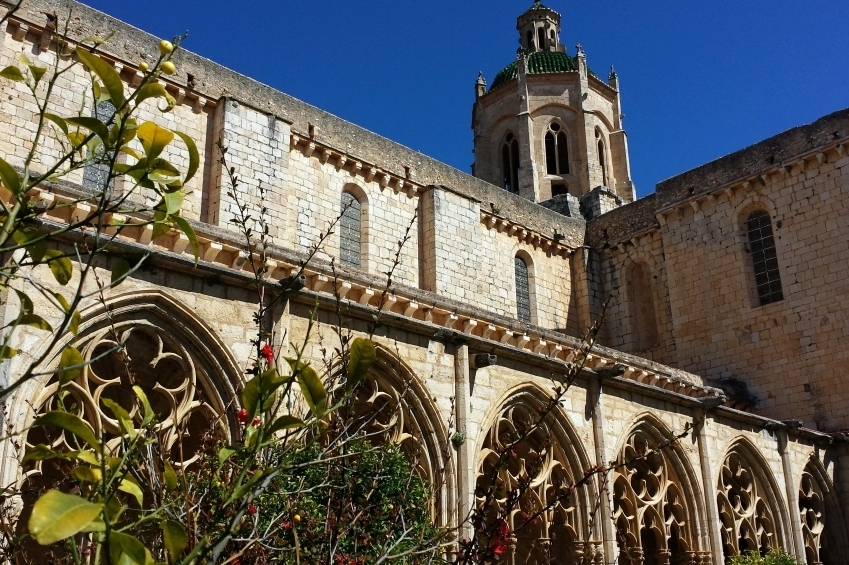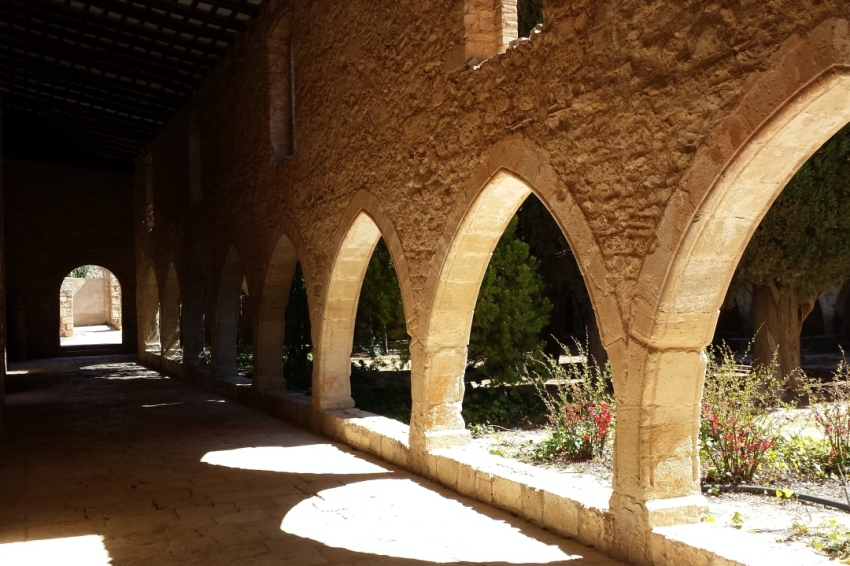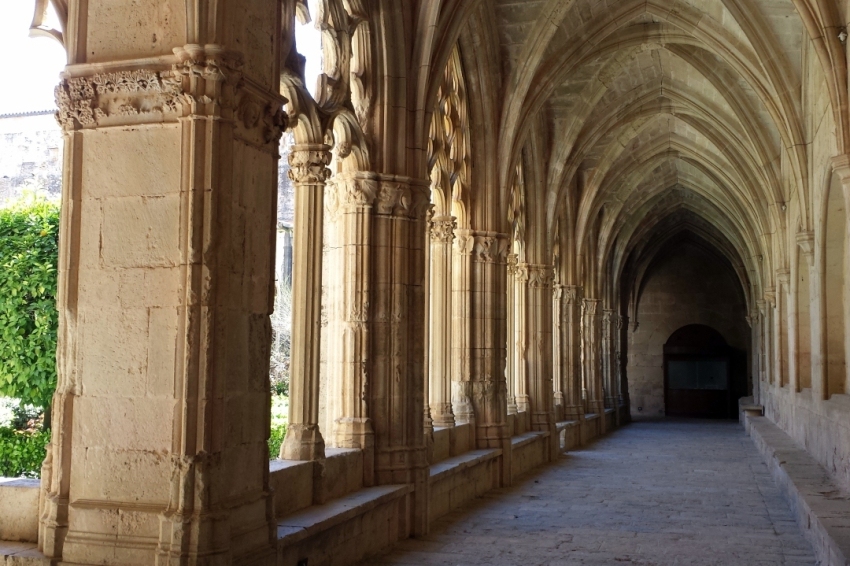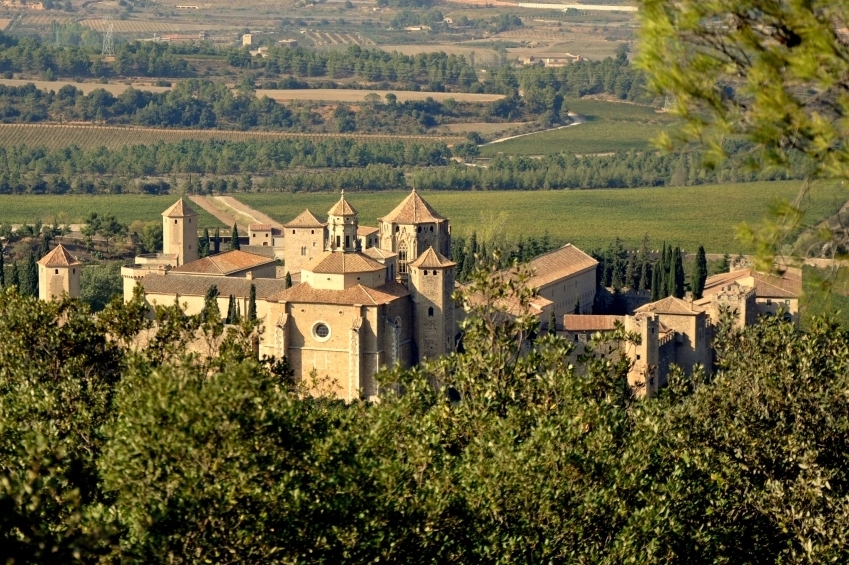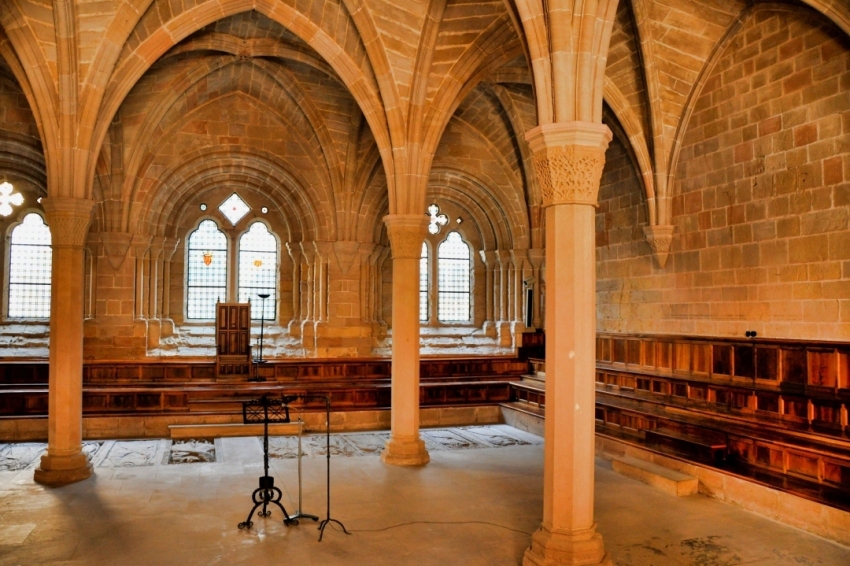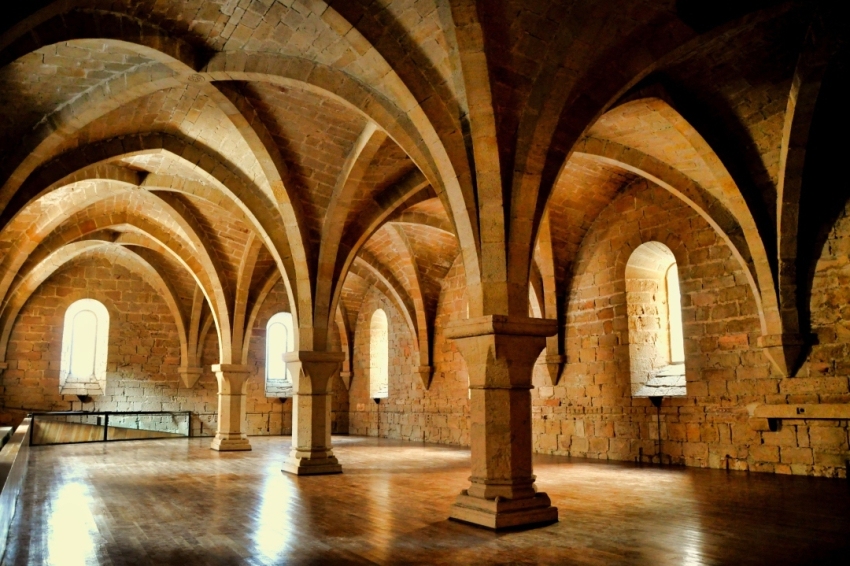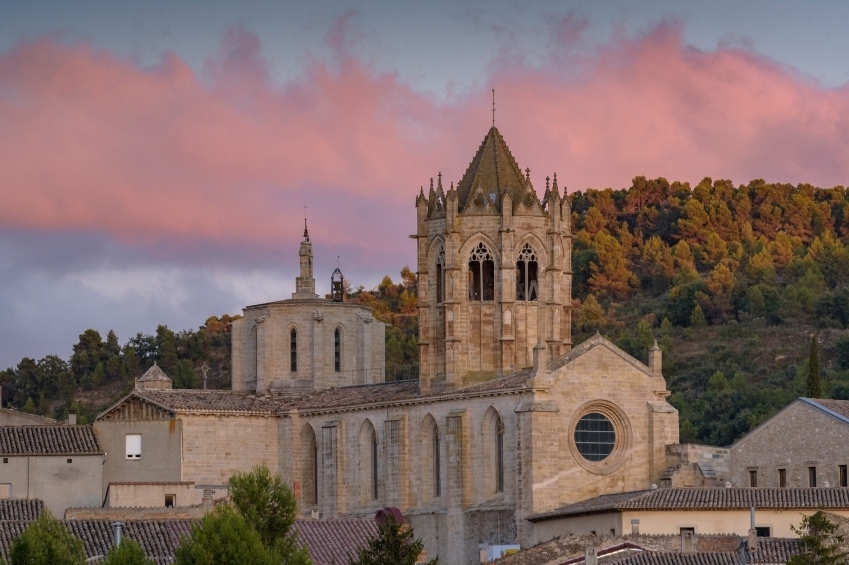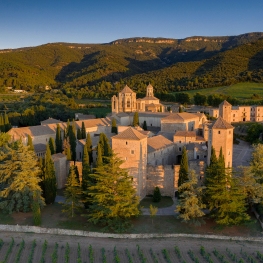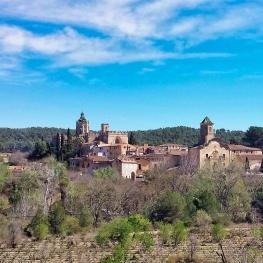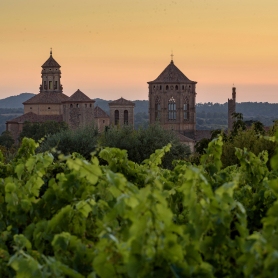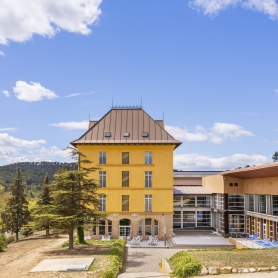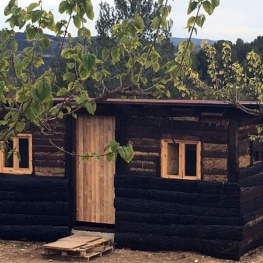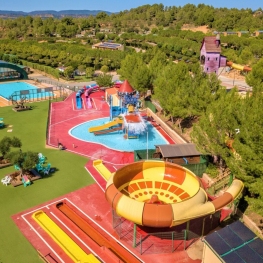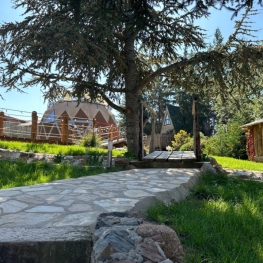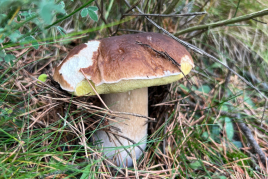The Cistercian Route, a genuine combination of nature, heritage and landscape
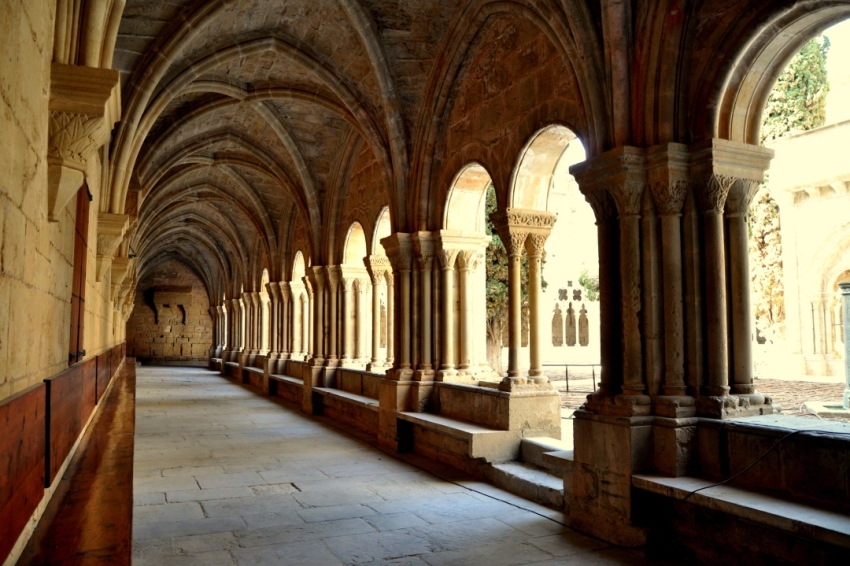
The Cistercian Route is a fascinating journey that takes you back to medieval times through three historic monasteries in Catalonia: the Poblet Monastery, the Santes Creus Monastery and the Vallbona de les Monges Monastery. With a tour through idyllic landscapes, you will discover the majestic monasteries that are witnesses of the architectural and religious legacy of the time.
Each monastery hides secrets and legends from the past, which will transport you to a distant and magical time. Are you encouraged to discover them?
Along more than 100 kilometers of circular route following the GR 175, as it passes through Alt Camp, Conca de Barberà and Urgell, the Cistercian Route awaits us to show us all its charms. Thanks to an exceptional combination of landscape, heritage and nature, the route offers us experiences as unique and genuine as listening to the singing of the monks of the Poblet monastery or participating in the prayers of the nuns of Vallbona.
The Cistercian Route is a journey back in time, an enriching experience for lovers of history and culture, and an opportunity to connect with our deepest essence in a serene and inspiring environment.
Royal Monastery of Santes Creus
The Monastery of Santes Creus is a Cistercian monastery located in the Alt Camp region, between the sea and the mountains. The visit of the monastery will allow us to know at the same time a region with a strong role of gastronomy and traditional culture, the region of the calçots and the castells par excellence. It is considered one of the best examples of Cistercian architecture in the Iberian Peninsula and has been declared a National Monument.
The monastery was founded in 1158 by Ramon Berenguer IV and his wife Peronella, as a subsidiary monastery of Poblet. The main building of the monastery is the church, dedicated to Santa María, which stands out for its sobriety and simplicity, characteristic of the Cistercian style. The church has a Latin cross plan with three naves and a chancel with an ambulatory and radiating chapels.
Another prominent part of the monastery is the cloister, built in the Gothic style, with pointed arches and capitals decorated with plant and animal motifs. It is a quiet and secluded space where the Cistercian monks carried out their daily activities and meditation.
Throughout the centuries, the Monastery of Santes Creus was an important religious and cultural center. It housed a grammar and rhetoric school, a library and various craft workshops. During the Middle Ages and modern times, the monastery had great economic and territorial power.
Although it was abandoned and partially destroyed during the 19th century, in 1921 it was declared a national monument and its restoration was ensured. It is the only one of the monasteries on the Cistercian route that does not have a monastic life and therefore allows us to explore all its corners thus becoming, for a while, monks of the Cistercian order.
Today, the Monastery of Santes Creus can be visited and is a major tourist attraction in the area. Visitors can tour the church, cloister and other spaces of the monastery, discovering its rich history and architecture. Exhibitions and other cultural activities are also organized in the monastery.
It is worth noting the two cloisters, especially the largest, due to the meticulousness of the capitals of the columns, mostly the work of an English builder. We will also see the bedrooms, considered to have extraordinary acoustics, which is why it is currently used as a classical music concert hall, apart from the multitude of perfectly preserved rooms and buildings outside the monastery, such as the royal palace or the Romanesque church of El Plan.
With its church and cloister, it offers visitors the chance to step back in time and explore the monastic life of bygone eras. It is a site steeped in history and a must for lovers of art and culture.
The monastery is part of the Cistercian Route, together with the monasteries of Poblet and Vallbona de les Monges. This route allows you to discover the three most important Cistercian monasteries in Catalonia and discover their cultural and spiritual legacy.
Royal Monastery of Poblet
Four kilometers southwest of the center of Vimbodí and Poblet stands the majestic Poblet Monastery, but to get there you will have to cross the Poblet Forest. This natural area, classified as a Natural Area of National Interest, hides among its lush vegetation a multitude of perfectly indicated corners where you can walk. We will highlight the "La Pena" viewpoint, located near the forest house, as it offers spectacular views of the region, La Fuente del Boyo and the Puente del Salt as picnic areas where you can take a dip. Finally, two recreational areas have been set up, with water, tables, stoves, parking... called Barranco de Castellfollit and Les Colònies, perfect for going with children.
The Poblet Monastery was founded in 1150 by King Ramón Berenguer IV of Catalonia and his wife Queen Peronella. It was established as a Cistercian monastery and became one of the most important monasteries in the Iberian Peninsula during the Middle Ages. The monastery played a key role in the repopulation and development of the area.
The monastery was built in the Romanesque style but Gothic style elements have been added over the years. The cloister, the church and the abbey palace stand out. The monastery also has a large chapter house, a staff room and a library.
The monastery was abandoned and in ruins during the time of the confiscation, but it was restored and recognized as a National Monument in 1930. Currently, the Poblet monastery is a UNESCO World Heritage Site and is home to a community of Cistercian nuns who continue to live and work in the monastery.
Poblet Monastery is open to the public and offers guided tours to discover its rich history and architecture. The tour includes access to the church, the cloister, the abbatial palace and other important spaces. You can also visit the chapter house and the library, where numerous manuscripts and old books are kept.
The Poblet Monastery is one of the main tourist attractions in the Conca de Barberà region and a must for lovers of history and art. The surroundings of the monastery offer a privileged natural environment, perfect for walks and excursions.
Royal Monastery of Vallbona de les Monges
From Maldà, as well as from a large part of the surrounding towns, we will find indications of the Monastery of Santa María de Vallbona de les Monges.
The Monastery of Vallbona de les Monges is a Cistercian monastery located in the La Segarra region, in the province of Lleida. It is one of the three female Cistercian monasteries that are still active in Catalonia.
The monastery was founded in 1153 by Ramon Berenguer IV, as a female monastery of the Cistercian order, although it was not finished until the 16th century. It was built in a Cistercian Romanesque style, characterized by simplicity and austerity, although you can find different architectural styles, a sample of the architectural evolution during the years of its construction. The cloister galleries, for example, each have a different style, Arabic, Romanesque and Gothic.
The main building of the monastery is the church, dedicated to Santa María de Vallbona, which stands out for its simple and pure lines.
The Vallbona de les Monges Monastery has been a religious and cultural center for centuries. During the Middle Ages, the living Cistercian nuns performed agricultural and craft tasks to maintain the monastery. They were also known for their dedication to studies and their literary production.
The war affected the monastic life of Vallbona, even causing the monastery to be vacated and looted for short periods of time, but with the persistence of the nuns, the financial aid of the nobility and later with the rehabilitation plans, we can currently know the inch by inch monastery almost as it was built.
Today, the monastery is still a space for monastic life, but it also hosts tourist visits and cultural activities. Visitors can tour the dependencies of the monastery, such as the church, the cloister, the chapter house and the monastic cells. There is also an interpretation center that offers information about the history and monastic life of Vallbona de les Monges.
The Monastery of Vallbona de les Monges is a testimony of Romanesque architecture and medieval monastic life in Catalonia. It is a place of peace and seclusion that invites visitors to go back in time and discover the cultural and spiritual richness of this monastic community.
Cistercian route on foot or by bicycle
The Cistercian Route can also be done on foot or by bicycle. It has a total length of approximately 105 km, and is perfectly signposted with the GR, white and red marks.
As it is a circular route, it can be started from any point on the route. If you want to do the entire itinerary, we recommend planning the stages in several days to enjoy the most, having the necessary time in each space.
You can also do simple and independent sections suitable for the whole family and combined with activities of all kinds: wine tourism, visiting the small wineries and wine cooperatives of Conca de Barberà, artisan workshops in the area, Poblet ceramics, etc.
The classical route can be divided into three stages, from monastery to monastery.
- Santes Creus – Poblet: 35.3 km and 7 and a half hours
- Poblet - Vallbona de les Monges: 23.55 km and 5 hours and a quarter
- Vallbona de les Monges - Santes Creus: 45.3 km and 9 and a half hours
This walk will allow you to see in detail the terrain where the most important Cistercian monasteries in Catalonia are built. If you go with time, you can visit some of the nearby towns that we have mentioned, as well as the Monasteries and the natural landscapes that surround them. A highly recommended option.
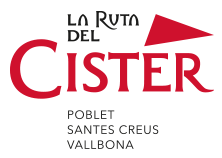 You will find more information about the Cistercian Route at www.larutadelcister.info.
You will find more information about the Cistercian Route at www.larutadelcister.info.
What to do
Reial Monestir de Santa Maria de Poblet
Vimbodí i Poblet (a 3.5 Km)A magnificent architectural complex located among the most prominent monasteries in Europe.…
Reial Monestir de Santes Creus
AiguamúrciaThe Royal Monastery of Santes Creus is located on the banks of…
Reial Monestir de Santa Maria de Vallbona
Vallbona de les MongesAn extraordinary space in which the passage of time is shared with…
Where to eat
Iberik Rocallaura Balneari
Vallbona de les Monges (a 4.3 Km)Iberik Rocallaura Balneari is located on the Cistercian Route, in the municipality…
Bodega Miquel Jané
Font-rubí (a 24.9 Km)Discover the world of wine with our comprehensive viticulture and oenology courses,…
Where to sleep
Camping Montblanc Park Capfun
Tarragona (a 11.5 Km)In the interior of the Costa Daurada, the Montblanc Park campsite offers…
Iberik Rocallaura Balneari
Vallbona de les Monges (a 4.3 Km)Iberik Rocallaura Balneari is located on the Cistercian Route, in the municipality…
Hotel rural - Xalet de Prades
Prades (a 11.6 Km)Immerse yourself in the nature of the Sierra de Montsant Natural Park…

